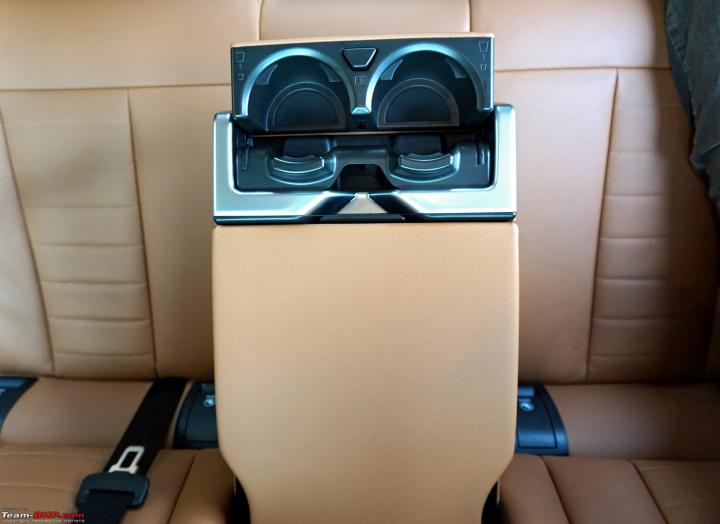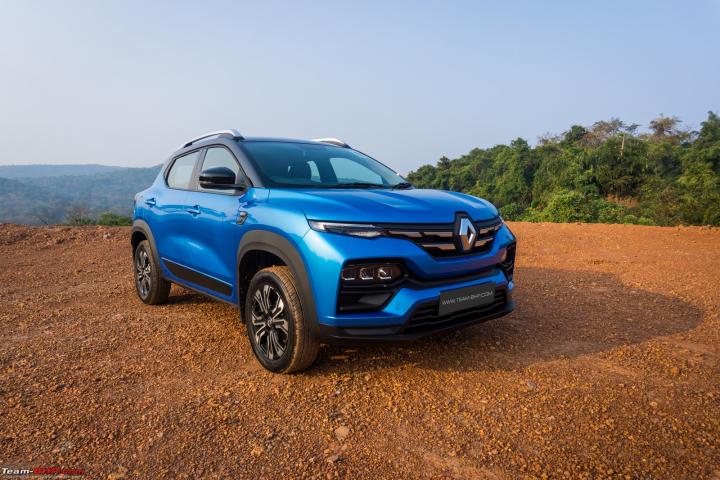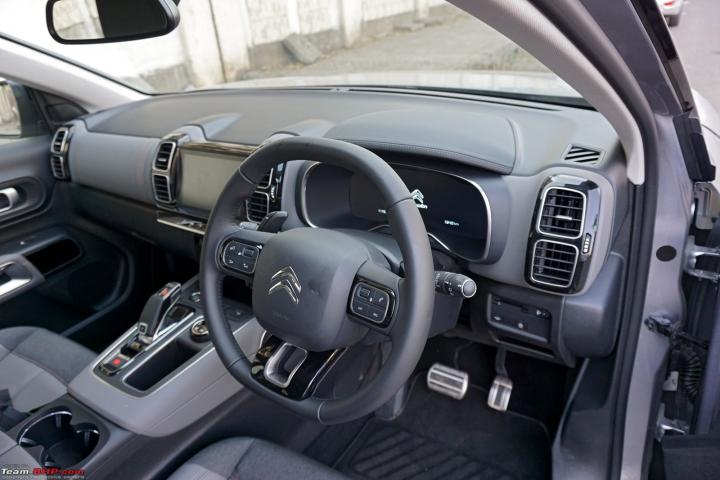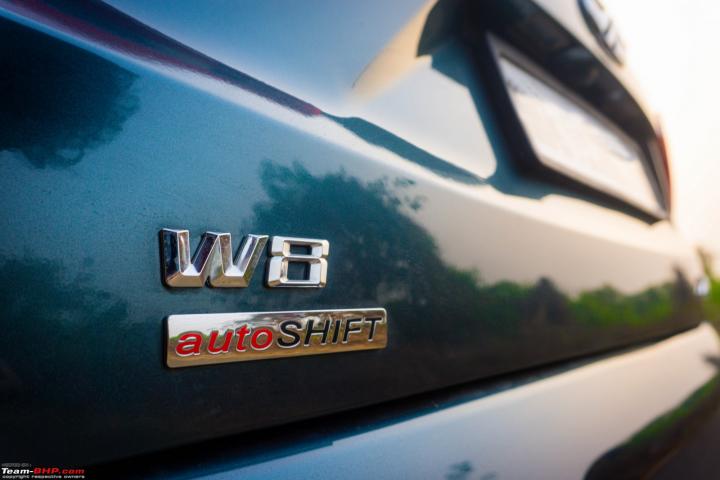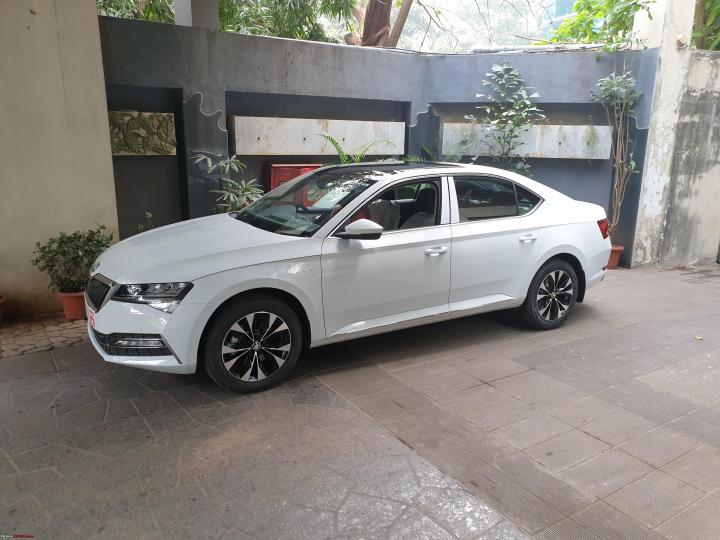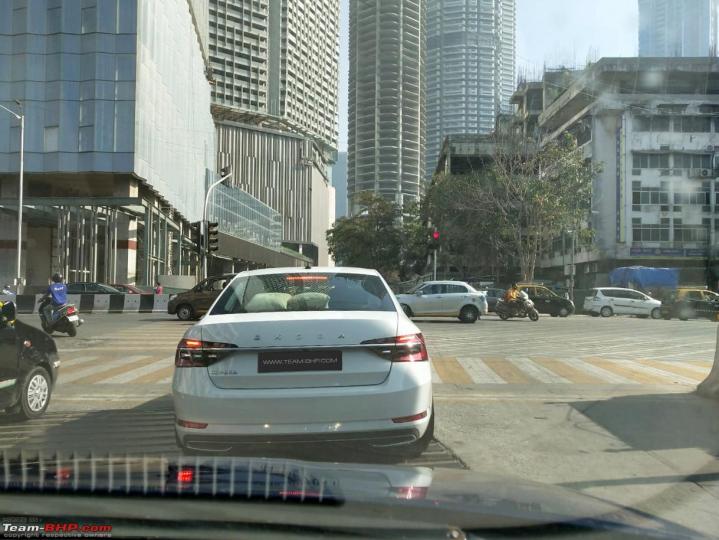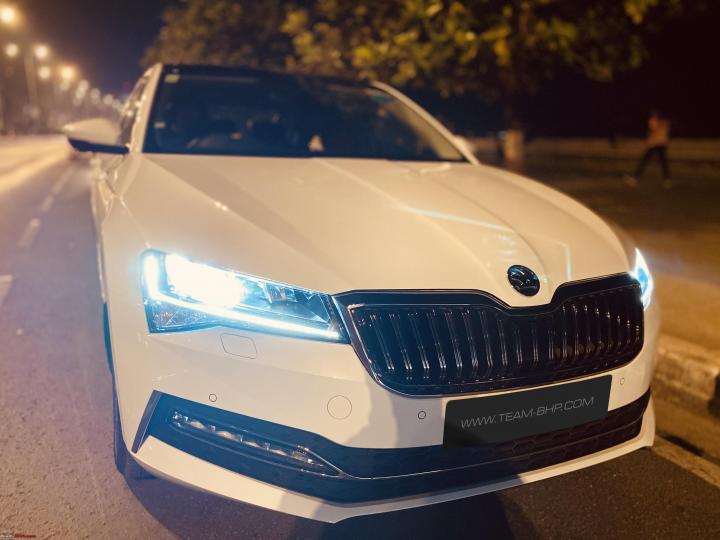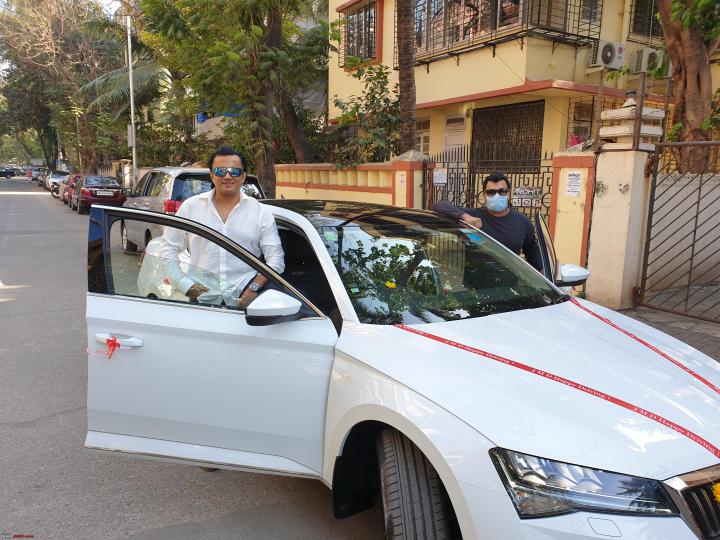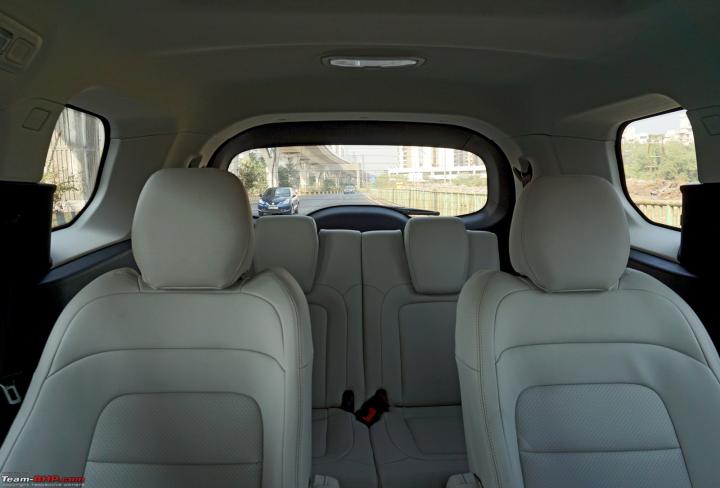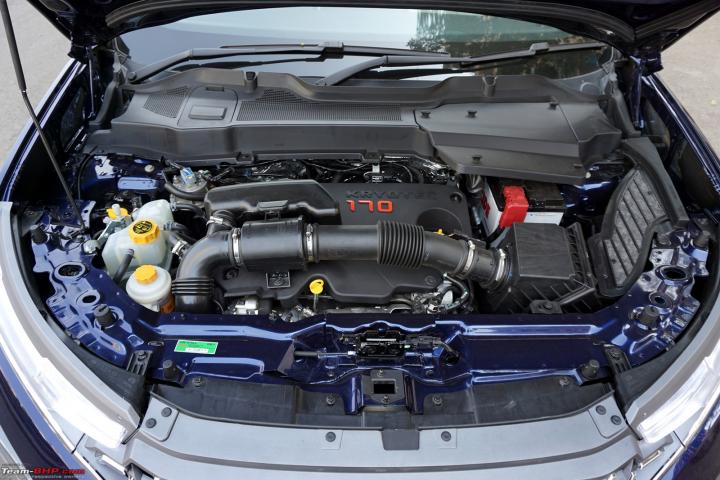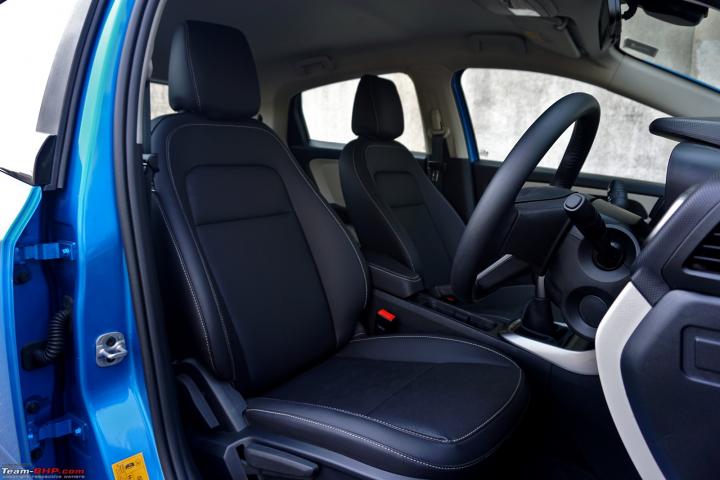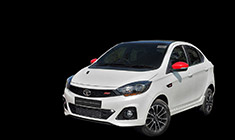News
BMW 3-Series LWB : Our observations after 5 days of driving
The 320LD continues with the B47 diesel engine which was launched a couple of years ago. Power and torque remain the same at 188 BHP and 400 Nm. 0-100 is claimed at 7.6 seconds, which is 0.8 seconds slower than the regular sedan.
BMW 3-Series Gran Limousine 2.0L Diesel AT Review
Will be a tough choice for enthusiasts between the terrific 330i petrol (Review: BMW 330i (G20)) and this diesel which is equally a jewel of an engine!
The 320LD continues with the B47 diesel engine which was launched a couple of years ago. Power and torque remain the same at 188 BHP and 400 Nm. 0-100 is claimed at 7.6 seconds, which is 0.8 seconds slower than the regular sedan. The difference is only 0.4 seconds for the petrol variant.
After plonking myself into the driver's seat and pressing the start button, one immediately notices how much more refined it seems as compared to the older F30. The engine is a distant hum rather than the semi rattle of the older gen, and the vibration is greatly reduced too. The refinement feels a level up.
The 8-speed gearbox in this seems even better calibrated (one would doubt its possible) than in the older F30 gen, and the shifts are a tad bit smoother and less jerky under part throttle. Driving inside the city at low to moderate speeds is perfectly comfortable with the gearbox keeping the engine relaxed, and it will definitely be a good experience for the rear passengers. Driving enthusiastically, the gearbox is even more responsive, downshifting even quicker, and with faster feeling upshifts which give a small jerk in Sport mode. All in all, it does the job perfectly.
When it comes to the powertrain, not much is needed to be said. Its tried and tested, and been available for over 5 years, with a good reliability record in my opinion. Its got the same power figures as before, but it feels a tad bit more peppy in the newer chassis. More than enough torque is available to push you back into your seat, and it revvs freely to the red zone, which is now more pleasing with the better refinement. Like all German 2.0 diesels, this one too is an all-rounder. It will happily cruise in the city, give you fast performance on the highway, and consistently deliver respectable fuel economy.
The car comes equipped with speed warnings for 80 and 120 km/h and the beeps are loud and annoying. Further, the music volume is lowered when the beeps come on (Related thread)!
The suspension, I believe has been tweaked for the long wheelbase. There wasn't much to complain about in the regular 3, which is a near perfect setup. And this seems a tad bit more passenger-focused, with better refinement at low speeds (though the 330i we drove was on 18", while this rides on 17"). Bumps and general unevenness are taken care of without much noise or vibration being felt inside, and on the whole, the ride feels comfortable. At the same time, what is heartening to know is that the long-wheelbase 3 is still fun to drive. With the communicative and well-weighted steering, the suspension isn't sloppy at all, in spite of being softened for the LWB. The car needs to be really hustled, for one to feel that there is a tad bit more body roll, and a very slight bit of resistance to quick direction changes as compared to its sibling with a shorter wheelbase. This really makes the 320LD into a proper all-round package, one which can be sat in behind the chauffeur, and a car which can be pushed to the limit when needed.
News
BMW 3-Series Gran Limousine LWB Review : 12 Pros & 12 Cons
Quite a master-class move by BMW in bringing the LWB car here, inspired no doubt by the E-Class LWB. Indians love rear legroom, even if they aren't chauffeur-driven.
BMW 3-Series LWB Pros:
- Very welcome increase in rear legroom & a comfy rear seat
- Doesn't look stretched or weird at all. Proportions are good & the car looks handsome
- Maintains fun-to-drive nature, despite the comfort-oriented changes
- Both engines are simply fantastic! Practical, fun, rev-happy
- The ZF 8-speed AT is the best gearbox in the segment
- Comfortable ride quality. Suspension has been retuned for this LWB version
- We love what BMW has done with the G20’s steering. It’s enjoyable to use
- Lovely cabin, premium build, very supportive seats & a fab driving position
- Enhanced kit includes a 16-speaker sound system, 360-degree cam, panoramic sunroof…
- BMW’s strong track record for reliability (among the luxury marques)
- 5-star NCAP rating & a laundry list of safety equipment
- Worth the extra money over the regular wheelbase car, in my opinion
BMW 3-Series LWB Cons:
- Price is cutting it too close to 5-Series territory (especially after discounts on the 5)
- Sad boot space with the spare wheel underneath
- Surround view, HUD & keyless entry are only in the M-Sport variant
- 320Ld is offered just in the Luxury Line trim (not M-Sport)
- Getting too big & heavy (320d = 1700 kilos) for a model that’s known as a “sports sedan”
- At the very limit, the regular wheelbase 3-Series is more fun to drive
- Rear floor hump is enormous! Car is better as a 4-seater than 5
- Low stance means ingress / egress aren’t senior-citizen friendly
- Runflat tyres come with many compromises, wear out soon & are expensive to replace
- We hate the all-digital instrument console. Also, the rev counter is weirdly inverted
- The 3-Series LWB has a w-i-d-e 5.9 meter turning radius!
- At this price, we expect goodies like Adaptive LEDs, ventilated seats…
Click here to read Team-BHP's detailed BMW 3-Series Gran Limousine LWB Official Review
News
Renault Kiger 2021: 51 observations after a day of driving
With the Kiger, Renault has a genuine shot at shooting past Toyota & Honda and doing 13,000 - 15,000 sales / month. The Kwid & very intelligent Triber already bring in a couple of thousand sales each month, while the Kiger will only add to that tally further. The Kiger is the Nissan Magnite's close sibling and the two are almost the same under the skin.
Renault Kiger 1.0L Turbo-petrol Driving Report
With the Kiger, Renault has a genuine shot at shooting past Toyota & Honda and doing 13,000 - 15,000 sales / month. The Kwid & very intelligent Triber already bring in a couple of thousand sales each month, while the Kiger will only add to that tally further. The Kiger is the Nissan Magnite's close sibling and the two are almost the same under the skin.
The Kiger is offered with two engine options – a 1.0L, 71 BHP naturally aspirated petrol and a 1.0L, 99 BHP turbo-petrol. Both are offered with a 5-speed manual transmission as standard and get the option of an AMT for the naturally aspirated version or a smooth CVT for the turbo-petrol. Ex-showroom prices start at Rs. 5.45 lakh for the base variant and go up to Rs. 9.55 lakh for the top-end 1.0 turbo-petrol CVT (related news).
I got to drive the Renault Kiger 1.0L turbo-petrol with the 5-speed manual transmission at the media drive in Goa. Here are my quick and brief observations:
- If you found the Nissan Magnite a little quirky in its appearance (I personally did), then the Kiger is probably good news for you. Looks are of course subjective, but I will say that the Kiger is the more handsome one to my eyes. And it does look modern.
- Renault has gone for a coupe-SUVish look with a sloping roofline and a rising window line which make it look more like a beefed-up hatchback.
- While the overall build quality is satisfactory, you can tell that the car is built on a budget. The doors are not heavy and there is some flex in the body panels. But at this price point, it is acceptable.
- All variants get 16-inch wheels with only the top-end RXZ variant wearing alloys. They are shod with 195/60 R16 Ceat SecuraDrive tyres. The spare is a 15-inch steel rim with a 185/65 tyre.
- Step inside and you're greeted by a pleasant cabin design with subtle modern touches. You will also notice the Renault diamond logo theme across the cabin (seat covers, door pads, etc).
- Plastics are hard as you would expect at this price point, but they don't scratch that easily. Yes, it feels budget-friendly, yet not cheap.
- A/C control switches and buttons on the center console are backlit, which is a very nice touch. You also have a switch on the center console for ambient lights!
- Getting in and out of the car is more like in a raised hatchback - easy. You will need to watch out for the edge of the roof while getting out though. Once inside, the cabin width is adequate and it does feel reasonably spacious. There's decent headroom in the front as well as rear. Even with the seat all the way back, there's enough legroom for the rear passenger.
- The front seats are draped in black fabric and the top-end variants get side airbags in them, so don't use seat covers. The seats look great and overall support is satisfactory. Not the best out there, but comfortable for the most part.
- The steering is adjustable for height. The driver's seat is adjustable for height too and has a good range. Finding your perfect driving position in this car isn't difficult.
- Ergonomics are good (unlike some of the old Renaults with their French quirks). Everything is easy to reach in the cabin, and you'll feel right at home as soon as you get in the driver's seat.
- The big 7-inch instrument cluster is easy to read and very detailed. A unique feature here is that the screen displays different information in different drive modes. Sport mode includes HP and Nm meters along with a G-Force meter.
- Frontal visibility is good, but if you like being seated low, the A-pillar and ORVM will form a sizeable blind spot. The IRVM is small and thick C-pillars further restrict the rearward visibility.
- Space utilisation & practicality in the Kiger are just excellent. For starters, all 4 doors can hold a 1L bottle with some space left over for other knick-knacks.
- You have 2 glove boxes on the dashboard with a total volume of 14.9 liters. The center console has about 7.5 liters of storage space in it. Note, the cupholder tray is removable.
- One of the most noteworthy features is the wireless smartphone integration (Android Auto and Apple CarPlay).
- Another interesting feature is that the air-conditioning gets an inbuilt PM 2.5 air filter. There's also a proper air filter available as an accessory.
- The RXT and RXZ variants get an 8-inch touchscreen. The touchscreen has a simple layout. It's not cluttered with unnecessary functions and settings, so finding something you actually need is quite easy.
- The screen has a sort of matte finish on it which doesn't leave a lot of fingerprints. One gripe with the screen however, is that the buttons on the side are screen-integrated and not physical buttons which are so much better for basic operations (i.e. you don't have to take your eyes off the road to operate them).
- Rear view camera display on the screen is good. You can also adjust the brightness, contrast and saturation of the display.
- The sound quality from the (4 speaker + 4 tweeters) Arkamys system is fair for the price. One strange behaviour I noticed with my phone was, while playing songs through Bluetooth (not wireless CarPlay), the volume level was half. Had to crank it up to full for the song to be audible. Worked well in all other scenarios (radio and CarPlay). Weird.
- The rear seats are placed at a comfortable height, so even elderly folk will find it easy to get in and out of the car. While the seats themselves are comfortable, I found the backrest angle to be too upright for my liking.
- On the rear seat, I felt I would be comfortable with a little more under-thigh support (I'm 5'10" tall). That said, shorter & medium-height folk would be quite comfortable.
- There's a good amount of headroom and knee room. Behind my own driving position, I had a few inches of knee room. Even with the front seat pushed back all the way, it wasn't too bad (similar experience to an economy flight seat). That's saying a lot for a compact car!
- Seating three people abreast will be a task. The floor hump is small and not intrusive.
- You get a nice and wide armrest with two cupholders and a phone holder. You also get rear A/C vents and a 12V charging socket.
- Adding to the excellent space utilisation, the Renault Kiger has the biggest boot in the segment at 405 liters. The rear seats are split in a 60:40 ratio. Folding the backrests down expands the boot space to 879 liters. The loading lip, however, is high, so you will have to lift your luggage while loading. You'll find baggage hooks on the side and the spare wheel has been placed beneath the boot floor. No boot lamp provided, which is a very obvious and sad omission.
- The Kiger is powered by a 999cc, 3-cylinder turbocharged petrol engine. Called the HRA0, this engine produces 99 BHP and 160 Nm, which is healthy, although there are rivals that offer more power. The car's light kerb weight makes it agile on its feet and there is enough grunt in this motor to keep most drivers happy.
- If you want to know how the CVT drives, click here (same engine & CVT in the Magnite) and read the second half of that post.
- On startup, being a 3-cylinder, there is slight body shake and a few vibrations do come into the cabin. Faint vibes are felt on the steering, pedals and the driver's seat.
- The turbo-petrol has a fair low-end and yes, the car clears the 2nd gear speed breaker test; it's certainly not dead off-boost. Some lag is there of course, yet it's well-controlled. That said, you have to be a little patient when pulling from low rpms in 2nd gear.
- Mid-range is punchy. So, keep the engine on the boil and you can have some fun with this car.
- The engine revvs till 6,500 rpm, but not happily as it groans & moans at the redline in a very crude manner. By this point, power has started tapering off and you will have already shifted up.
- Driveability is good and you won't find the need to downshift often, although there is some lag in the higher gears.
- In 5th gear, the car can cruise at 100 km/h & 120 km/h @ ~2,300 rpm & ~2,900 rpm respectively.
- Unlike the Magnite 1.0 MT, the Kiger gets 3 driving modes - Normal, Eco and Sport. These modes alter the throttle response and steering weight. There's not much difference in the Eco and Normal mode, where the steering is light and throttle response is slightly dulled down. In Sport mode, the steering is noticeably firmer and throttle response is quick as well.
- 5-speed gearbox offers a poor shifting experience. I found the shift action to be quite clunky and it requires some effort to use. My suggestion = go for the smooth CVT automatic.
- The clutch pedal too has some weight...more weight than you'd expect in such a small car. Also, the travel is long and the bite point is high. Moreover, off standstill, it's not that smooth.
- Coming to NVH levels, the Kiger does well at slow speeds and around town. Upon revving, you can hear that familiar 3-cylinder thrum. Yet, this noise is not excessive. Even while cruising on the highway, the engine is audible, but not irritatingly so. It's above 5,000 rpm that the motor gets loud.
- In such a cheap car, I would have expected wind & road noise to be excessive, but no. The cabin is acceptably insulated.
- The ride quality of the Kiger appears to be better than the Magnite. Where the Magnite was very firm, the Kiger is more absorbent. While there is a hint of underlying firmness to the suspension at low speeds, it's not excessively so.
- On a rough patch of road, I found myself doing good speeds without any issues. You can hear the suspension working, but little is transmitted into the cabin.
- On the open road, straight-line stability at high speeds is satisfactory. The car doesn’t feel twitchy over bumps & undulations.
- Coming to handling, the Kiger behaves like a normal family crossover. While there is some body roll, it's not excessive. You can even hustle the car through a series of twisty roads confidently.
- Grip from the 195/60 Ceat SecuraDrive tyres is acceptable for the average Mahesh. Push hard and the tyres start chirping.
- The electric power steering is light and smooth in Normal / Eco modes at parking & city speeds. Along with the small size, this makes the Kiger a very easy car to drive in urban conditions.
- While Sport mode adds weight to the steering, it feels artificial. There's vagueness in the center and you don't feel very connected if you're driving hard in the ghats. Good for highways & high speed though.
- The Kiger comes with an unladen ground clearance rating of 205 mm, which is second only to the Tata Nexon (209 mm). This is more than enough to take on the worst of Indian roads.
- The Kiger is equipped with disc brakes at the front and drums at the rear, with ABS + EBD. The brakes perform as expected. Do note that the second half of the brake pedal travel is quite sensitive, this will take a couple of km to get used to.
- The list of safety features in the Kiger isn't as long as the Magnite. Major misses from the Nissan include ESP, traction control and hill-start assist. Even the Datsun Go and Go+ get ESP. This is a disappointing omission on Renault's part!
- On the flip side, the Kiger gets 4 airbags (Magnite gets only 2) and front parking sensors (as an added accessory). The Kiger hasn't been crash-tested yet, but the Nissan Magnite scored a 4-star rating in the ASEAN NCAP crash tests. We expect the Renault to perform similarly.
Continue reading the discussion on the 2021 Renault Kiger on our forum.
News
Citroen C5 Aircross 2021: Observations after 1 day of driving
The C5 Aircross offers the kind of ride quality that is simply perfect for Indian roads. Even the expressway behaviour at speed is nice and composed. Your family will be very happy doing long distance journeys in the Citroen.
Citroen C5 Aircross Exterior Review

Design & Styling
The C5 Aircross is unique when it comes to styling and quite a head-turner. It looks fantastic, and offers something "different" which makes it stand out from today's Japanese, Korean and Indian cars. Even GTO, whose tastes are very traditional, loved the looks and stance of the car. It's a different kick for sure. There is definite French quirkiness, but somehow, we don't have complaints.
On the road, other drivers, bike riders, pedestrians, old and young – all looked eagerly at our test car, with some wanting to know more about this unfamiliar maker. The car gets traditional Citroen badges, LED daytime running lights and tail-lamps, plastic cladding on the sides, silver inserts, fake air vents on the side, 18-inch alloy wheels and roof rails. The vehicle will be available in 4 single-tone body colours and 3 dual-tone shades.
Build Quality, Fit & Finish
The C5 Aircross has a monocoque construction and is built on the PSA Group's EMP2 platform. This platform is used by many other cars & many brands (including Opel and Toyota), but none of them are sold in India. The car is very solidly built. The doors & tail-gate have a good deal of weight to them and there’s not much flex in the body panels. The bonnet is not quite as heavy, but it's far from light or flimsy. Interestingly, the heavy doors feel like that of a tijori (vault) and shut with an incredibly satisfying thud. GTO looked funny, opening & closing the driver's door multiple times in succession just to enjoy its sound & feel. Overall fit & finish are just as you'd expect from a European car. Citroen hasn't shared the kerb weight of the C5 Aircross, but the Euro-spec car with the same engine weighs about the same as the Jeep Compass (~1500 kilo range).
Wheels & Tyres
Both variants gets funky 18” 'swirl' two-tone diamond cut alloy wheels with grippy 235/55 Michelin Primacy 3 tyres, which look proportionate to the metal on top. They fill up the wheel arches well, especially the front which isn't usually seen in India. While ride quality is very good, we wish Citroen had chosen a more sensible R17 size (or R16) as it would offer an even cushier ride + cheaper tyre replacement costs + lower chance of alloy wheel damage (thanks to a taller tyre sidewall) on broken Indian roads.
Ground Clearance
Citroen hasn't revealed the exact ground clearance of the car. The wheel - tyre combination fills up the wheel arches very well. In fact, the gap between the tyres and wheel arches is tight. Citroen does not appear to have significantly raised the car's ground clearance for India, and we guess it didn't need to as the international GC rating is 230 mm! We didn't scrape the car anywhere in our test.
Standard & Extended Warranty
The Citroen C5 Aircross will come with a standard warranty of 3 years / 1,00,000 km. Extended warranty will be available at launch. As is always the case, we strongly recommend extended warranty coverage, especially for European cars.
Safety
The C5 Aircross is loaded with safety features such as 3-point seatbelts for all five occupants, 6 airbags, blind spot information system, ESP, ABS, hill-hold, hill descent control, traction control, ISOFIX child seat mounts (including for the front passenger seat), coffee break reminder, underinflation warning, front and rear parking sensors, reversing camera and auto door unlock on crash. The C5 Aircross was tested by the Euro NCAP in 2019. The standard car scored 4-stars in the crash tests, while the optional safety pack variant (which includes automatic emergency braking for cyclists) managed to get 5 stars.
Citroen C5 Aircross Interior Review

Cabin Design & Quality
Just like on the outside, the interior is also unique in many ways (e.g. split air vents). We love it! Sit inside and you know this is a premium product. The feel & design are appealing. The interior has a dual-tone metropolitan grey theme with silver, glossy black and chrome inserts. Glass area is sufficient. The dark-coloured interior doesn't feel as "airy" as a beige cabin, but it will conceal any signs of soiling better than a lighter theme. Soft-touch material has been used on the dashboard, and part quality feels good for the most part. Some of the plastic parts though - such as the glovebox & parts of the doorpad - feel rudimentary. A very premium-looking gear shifter and race car-like large paddle shifters have been provided. The pedals are finished in aluminium, which give them an upmarket look. Overall, the cabin feels well-built and durable. We didn't find any rough edges in the vehicle. Adding to the premiumness is a very uniquely European smell that you get in the cabin. This cabin aroma emanating from either the cabin materials or climate control makes the C5 Aircross one of the best smelling cars that we have sat in.
Space & Comfort
There is enough space at the front. Cabin width is healthy and so is the headroom. The electrically adjustable driver’s seat is superbly supportive. The seat slides back enough even for tall drivers to feel comfortable (typical of European cars). It comes with lumbar adjustment as well. Sadly, in such a premium car, the passenger seat gets manual adjustment and no lumbar adjust. Worse still, it's recline angle is controlled by a rotary knob like that of a Premier 118NE!! Expect your spouse to scoff at it. The leather & fabric upholstery is of good quality, with just the perfect amount of cushioning and padding. If you have a bad back, you will love this car on long trips. The center console is high and provides a sweet cocooning effect. It incorporates a fixed, long and wide leather-wrapped armrest which is placed at a comfortable height. The doorpads too host a leather-wrapped armrest which is useable.
Driving Position & Ergonomics
Ergonomically, we found the C5 Aircross to be user-friendly for the most part. The steering is good to hold, while the hornpad isn't hard to press. The horn itself is a nice-sounding, typically European dual-tone unit. The steering wheel is adjustable for height and reach, which makes getting the desired driving position easy. On the flip side, you cannot help noticing that this car has been engineered for LHD markets & no one bothered to make it perfect for RHD countries. The engine start/stop button, gear lever and electronic parking brake all have an LHD orientation. Accessing them just feels very unnatural & some drivers will have to stretch out to reach them. The instrument cluster is fully digital and customisable. This is a rare digital instrument cluster that me & GTO both gave a thumbs up too (even liked it more than in the BMWs). The colour combination & design are perfect + classy. The driving position is brilliant with a clean view of the road ahead. Even the dashboard is not set high like we see in many new models. At 5'10", not only could I see over the dash, but also the bonnet. However, rearward visibility is restricted by the small size of the windshield. The driver footwell gets a large & useable dead pedal.
Cabin Storage
The C5 Aircross does well in terms of cabin storage. There is a spot to park your smartphone at the base of the center fascia & a pair of cupholders on the center console. The door pockets are adequately sized, with no partitions or compartments. They can hold a variety of objects including 1L bottles and the knick knacks. The storage bin under the center armrest is massive! It has a section to hold a 1.5L bottle and I even managed to fit a small bag inside with ease. This storage bin is cooled. On the downside, the glovebox is weirdly shaped as the fuse box is located inside it. This restricts its carrying capacity. The glovebox doesn't have a cooling vent, but gets illumination. Coming to the rear, both front seats have seatback pockets and the rear doorpads get pockets that can hold a 1L bottle. Wait till you see the boot.
Air-Conditioning
The C5 Aircross gets a dual-zone climate control unit which is effective. The interior was chilled in seconds, although we would wait to read in the Team-BHP ownership reports how it fares during hot Indian summers. The car gets an onboard Air Quality System which works as an air purifier. As mentioned earlier, there's an amazing premium smell that you get from the climate control and the cabin. @ Smokers, please don't light up in the cabin & ruin this lovely aroma.
Features
Unique & Noteworthy Features
The C5 Aircross comes with most of the necessary features (including a panoramic sunroof and touchscreen head-unit with Android Auto and Apple CarPlay), but not connected car tech, wireless charging, ventilated seats, 360-degree camera, subwoofer and other such goodies that we have come to expect in premium cars (thanks to the Korean twins). Standout features include three individual rear seats which can be slid front + back + folded + reclined independent of each other, ISOFIX child seat mounts on the front passenger seat (we do NOT recommend placing a child in the front), handsfree tailgate opening, customisable instrument cluster, double laminated front windows and a windshield that keeps road + wind noise low. The car also gets park assist, Eco and Sport driving modes, 5 selectable terrain modes and blind spot monitoring.
Audio System & Sound Quality
The C5 Aircross gets an 8" capacitive touchscreen head-unit with 6 speakers, voice commands and Android Auto / Apple CarPlay. The size of the touchscreen is adequate and the interface is alright to use, but it does have some quirks. Visibility is good even under direct sunlight. That said, the touch response is not the quickest and the display clarity while using navigation through Google Maps / Android Auto was sad. The doors hold a speaker each, while the front doors also house a tweeter.
The audio system is nice and most owners won't complain. But at the price at which the C5 is expected to sell, we would have expected more speakers, a subwoofer and truly premium sound quality. Just doesn't feel "special" & special is what premium customers pay the extra rupee for. To put things in perspective, the cheaper MG Hector offers vastly superior sound quality. Further, the volume doesn't go as loud as we'd like. Even at max level 30, it's not really loud enough for those BHPians who love listening to blaring music on that late night or early morning joyride. Another weird touch = volume controls on the left side of the steering wheel, while the track change is on the right (most cars have all audio controls on the same side).
Rear Passengers

Rear Seat Comfort & Space
Ingress & egress are easy. The cabin rear uniquely features 3 individual seats which can be separately adjusted. The good part of this arrangement is that 3 adults of a moderate weight will sit nicely. But heavier passengers will find each seat to be narrow (guess they are designed for the slim French!). The seat bolstering won't be ideal for heavy folk as it will poke you and interfere with the support. Also, no center armrest due to this unique seat arrangement.
For me & GTO (both fit & slim Mods), the cushioning and padding of the rear seats was just perfect - its neither too soft nor too hard. All 3 seats get comfy adjustable headrests as well. The headroom & legroom are strictly adequate though. We set the front seat for my 5'10" driving position, and GTO (also 5'10") could sit behind. But just that. Two 6-footers will NOT be able to sit one behind the other.
The seatbacks are adjustable, although I don't see you using their adjustability as the backrests are comfortable only when reclined all the way. Back support is excellent. Under-thigh support is sufficient and occupants of the side seats can slide their feet under the front seats. While the floor is almost flat and the center console does not stick out excessively, the middle passenger will be happier placing his feet on either side of it. The rear windows are big and a lot of light comes into the cabin, which will keep occupants from feeling claustrophobic in this dark cabin. Rear occupants do get a/c vents and a USB port for charging.
Boot Space
Luggage space is a cavernous 580 liters & we found the boot to be perfectly shaped. You can easily go for driving holidays with luggage for 5. The C5 Aircross is also well-suited to airport duties for international passengers. Sliding the rear seats forward increases boot space to 720 liters. Further, the rear seat’s backrests are split and fold down almost flat for when you need to haul serious cargo. Folding the backrests down gives the C5 a luggage capacity of 1,630 liters. The boot also gets a couple of shallow storage compartments on the sides and tie-down hooks for a net. A light and 12V power socket have been provided in the boot, while Citroen has given a big 2-piece parcel tray above the boot area. Why 2 piece? The outer half rises with the tailgate, while the inner half stays in place.
C5 Aircross 2.0L Diesel Automatic Review
DW10FC turbo-diesel engine produces 175 BHP @ 3,750 rpm and 400 Nm @ 2,000 rpm:

The C5 Aircross will be available with just one engine & gearbox option - a 2.0L diesel mated to an 8-speed automatic transmission. Not offering a petrol puts the brand at a disadvantage as many customers now prefer petrols, although we can tell you this diesel engine is amazingly refined. The unit produces 175 BHP and 400 Nm which are healthy numbers & comparable to the Hyundai Tucson. The diesel engine is very smooth, refined and fast. It is quite tractable, which makes the car city-friendly. Throttle response is good and so is the driveability. The power delivery is linear in nature and passengers will be comfortable as there is no jerkiness or sudden kick from the turbo. The taller seating, good ergonomics, excellent frontal view, light steering and not-so-large footprint make the C5 Aircross stress-free to drive in the city. The turning radius of the car is 5.35 m, which is acceptable for the size.
Because of the engine & suspension, you will really enjoy this car on your highway drives. On the open road, the diesel’s 175 BHP and 400 Nm provide more than enough grunt to make the C5 Aircross a fast performer. The performance is enjoyable & you'll like taking the car to its max revs of ~4,800 rpm. What amazed us is that, even at these rpm levels, the engine sounds good and is beautifully refined. In fact, the refinement levels are so good that your passengers will think there's a petrol engine under the hood. The mid-range is strong and overtaking is a breeze. In terms of cruisability, the C5 Aircross will do 100 km/h & 120 km/h in top gear at a relaxed ~1,300 rpm & 1,800 rpm respectively. Yep, that 8th gear helps cruisability as well as fuel economy on the highway.
The 8-speed torque-converter AT (developed with Aisin) is butter-smooth in its operation, and only the slight change in engine pitch tells you when an upshift happens. When it comes to shifting speed, the transmission is acceptably quick, but not as fast as VAG's DSGs. Kickdown response time is satisfactory & it does not get confused either. The gearbox is in the right gear 99% of the time. A manual mode and racecar-like big paddle shifters have been provided. These are really nice, well-sized paddle shifters which look amazing and are great to use. Interestingly, they are mounted on the steering column and not the steering. Thus, they don't move as you turn the wheel. We prefer this kind of setup as its avoids confusion in fast corners. In summary, we'll say that the automatic gearbox is excellent; owners will be pleased.
The C5 Aircross gets 3 driving modes: Normal, Sport and Eco. Normal mode is the default when you start the car. Sport mode is what you should use when you're driving hard. Eco mode is genuinely useable on a daily basis, because the engine has 175 BHP on tap. We see owners using it in the city as well as for relaxed expressway cruising. Note that the Eco & Sport buttons need to be long-pressed to activate.
In addition to these, the C5 Aircross comes with standard, snow, all-terrain (mud, damp grass, etc.), sand and traction control off modes for tackling various terrains. An idling start/stop system has also been provided, which worked seamlessly on our test car.
Noise, Vibration & Harshness (NVH)
Citroen has done a fabulous job with the refinement levels. There is no body shake on start-up or shut down. At idling, you can hear some clatter from the engine, but it's nicely muffled on the inside. Stand outside the car and you'll notice how much of a difference there is in noise levels between out & in! Even at high revvs, the insulation is excellent & most passengers can be fooled into thinking it's a petrol engine. Wind and road noise are also very well controlled, including at triple digit speeds. Part of the reason for the wonderfully controlled NVH level is the use of double-laminated front windows and an acoustic windshield glass. These glasses help a lot in keeping outside noises out. The refinement levels are frankly superior to many Audis, BMWs & Mercedes' we've driven.
Mileage & Fuel Economy
The C5 Aircross has an ARAI rating of 18.6 km/l. 4-cylinder turbo diesels & 8-speed ATs offer good fuel economy in the city & more so on the highway, so owners will be satisfied in this area. What one must remember though is the 52.5-liter fuel tank is smaller than its rivals. The Compass and Tucson get 60 and 62-liter units respectively.
Citroen C5 Aircross Ride & Handling Review

Ride Comfort
The Citroen C5 Aircross comes with a MacPherson strut suspension with "double progressive hydraulic cushions" at the front and a twist beam axle with single progressive hydraulic cushions at the rear. Despite the 18" rims, the low speed ride is excellent! All the bumps & joints on the road are absorbed very well by the suspension. In fact, it is one of the best riding cars that I have tested in a long time (the last was the Hexa). The French really know how to give you a comfortable ride = the Peugeot 309, Logan, Duster and now, this Citroen. The C5 Aircross offers the kind of ride quality that is simply perfect for Indian roads. Even the expressway behaviour at speed is nice and composed. Your family will be very happy doing long distance journeys in the Citroen. What further aids comfort are the excellent, supportive seats.
Just the earlier week, we tested the Tata Safari (also with 18 inchers) and that isn't even close in terms of ride comfort. However, the pre-facelift Renault Duster (2019 and before) with 16-inch rims is still the benchmark for a magic carpet ride. If we give the pre-facelift Duster a 10 / 10 rating for ride quality, we will give the C5 Aircross an 8.5 / 10 score. We are sure that if Citroen gave the C5 Aircross 16 inch rims & taller tyre sidewalls, it would be a 10 / 10.
Handling & Dynamics
The Citroen has sorted road manners, but it's not sporty, or even as much fun as a Jeep Compass. High speed stability and composure are excellent - just as we would expect of a European car. There is no floatiness or bounciness on the highway. Expressway dips & undulations are dismissed well. You can confidently maintain high speeds over long distances. Very frankly, the high speed behaviour and overall feel of the car is comparable to Audis and Mercedes' costing Rs. 40-50 lakh.
In fast corners and on twisty roads too, the car has good poise. Sweeping curves can be taken at fun speeds and we're damn sure those Michelin tyres are contributing to the sorted dynamics too. Grip levels from the 235 mm Michelin Primacy tyres are impressive & it's nice to know that the ESP is there to help in an extreme situation.
Although, the driving experience is not what we would call sporty. A car like the Compass feels decidedly sharper, more agile & fun to drive on the twisties. It's clear that the Citroen's suspension is tuned more for comfort.
Steering
Like most modern cars, the C5 Aircross gets electric power steering. It is one-finger light at parking and slow speeds, which makes it very easy to pilot the car in the city. It weighs up acceptably at high speed. The steering wheel itself has a lovely design. It is small & sporty, but this isn't a steering that is "involving" for an enthusiast.
Braking
The C5 Aircross comes with disc brakes at the front & rear. The braking is powerful and the car comes to a halt from triple digit speeds in quick time. The pedal feel is sharp. It'll take a little getting used to when you are new to the car, yet we liked this sharp pedal feel.
Niggles & Problems
As a brand, Citroen isn't particular known for top reliability. Google up and you'll see several reports from UK & Europe that reliability can be patchy. That is unfortunately the case with almost all European brands, be it VW-Skoda at one end of the market or Audi-BMW-Mercedes at the other. Don't expect a "Fortuner" experience & be sure to get that extended warranty.
Continue reading the discussion on the 2021 Citroen C5 Aircross on our forum.
- Tags:
- Indian
- C5 Aircross
- Review
News
2021 Citroen C5 Aircross Review : 9 Pros & 9 Cons
The C5 Aircross crossover has the duty to establish the Citroen brand in India. This makes it a very important car for the company.
Citroen C5 Aircross Pros:
- A superbly engineered & properly premium crossover
- Very stylish exteriors & interiors! We love the design. It's matched to solid build quality
- Good quality cabin with comfortable seats, lots of storage & fantastic insulation
- 2.0L diesel engine is quick, efficient & extremely refined
- Smooth 8-speed AT gearbox impresses
- Excellent ride comfort and mature road manners. High speed behaviour is sorted too
- Large, well-shaped 580 liter boot gobbles up holiday / airport luggage
- Loaded to the gills with features such as a panoramic sunroof, handsfree tailgate opening, customisable instrument cluster, double laminated front windows, terrain modes...
- 4-star rating in the Euro NCAP crash test. 3-point seatbelts for all five occupants, 6 airbags, blind spot monitoring system, ESP, hill hold, hill descent control and more
Citroen C5 Aircross Cons:
- Rear legroom is strictly adequate. Two 5’10" adults can sit behind each other, but not two 6-footers
- No turbo-petrol engine (big miss), no AWD for tourers & no manual gearbox for MT fans
- Not really sporty to drive. Cars like the Compass are more fun
- Missing some features we expect today (connected car tech, wireless charging, ventilated seats, 360-degree camera, subwoofer…)
- The bolstering of the 3 individual rear seats is suitable for slim passengers, not heavier ones
- Audio sound quality is alright, but nothing special as you’d expect in a premium car
- Many competing crossovers & SUVs offer a 3rd-row of seats, which the C5 Aircross doesn't have
- The LHD orientation of many controls (gear shifter, e-brake, bonnet release, engine start button)
- Long-term reliability & after-sales service quality are big unknowns
Read Team-BHP's Detailed Citroen C5 Aircross Review
- Tags:
- Indian
- Review
- C5 Aircross
News
Mahindra XUV300 Petrol Automatic Review - 9 Pros & 8 Cons
The AMT unit has been developed in collaboration with Marelli (previously known as Magneti Marelli). And in the top-end W8(O) variant, you get all the features from the manual variant like ESP, hill-hold assist, rollover mitigation etc.
Mahindra XUV300 Petrol Automatic Pros:
- Fast performance from the impressive turbo-petrol, despite the AMT
- Surprisingly nice on the expressway, thanks to the power on tap, acceptable smoothness & good stability
- Improved AMT with hill start assist, drive & reverse lockout, creep disable on door open...
- Mature ride & handling package. Enjoyable high-speed behaviour
- A truly premium crossover. Good build, quality & refinement levels
- Great looking! Smart design has none of the usual Mahindra quirkiness
- Cabin has enough space for 5. Quality-wise, the interior is more like a Hyundai
- 5-star GNCAP rating & kit. 7 airbags, ESP, all-wheel disc brakes, TPMS, seatbelt reminders for all & more
- Loaded to the gills with equipment (front parking sensors, sunroof, cruise control, auto headlamps & wipers etc.)
Mahindra XUV300 Petrol Automatic Cons:
- The jerkiness at low speeds & in the lower gears can get very annoying!
- AMT doesn’t suit a truly premium crossover like the XUV300
- Expensive! Plus, for the same money, you can buy competitors with smoother ATs
- 257-liter boot is the smallest in the segment. There are cheaper hatchbacks which have a larger boot
- Concerns over niggles. TUV300 AMT owners went through a tough time
- Mahindra's after-sales service quality is a hit or miss. Remains a gamble
- Sad audio system by current standards. The bass, especially, is poor
- Some important features missing (parcel tray, rear air-con, steering reach adjustment etc)
Read Team-BHP's detailed Mahindra XUV300 Petrol Automatic Review
News
Skoda Superb 2.0 TSI Review : 14 Pros & 14 Cons
What I like:
- 75% of the A6 / E-Class / 5-Series luxury at 50% of the price
- Value for money price, enhanced by the discounts! Punches above its weight & how (my related article)
- Timeless, elegant styling with “big car” presence. Fit, finish & build quality are top class
- Awesome space and comfort, including at the rear. Beats luxury cars costing twice as much
- Classy dark-brown cabin is luxurious & practical. Cavernous 625 liter boot gobbles up big bags!
- Enjoyable 12-speaker Canton sound system includes a punchy subwoofer
- Insanely fun 2.0 turbo-petrol engine with 187 BHP & 320 Nm on tap
- Fast & improved wet-clutch 7-speed DSG (instead of the notorious DQ200 which I’d never buy)
- Comfortable ride quality is just perfect for Indian roads
- Surprisingly easy to drive for such a large car. Driving experience makes us smile
- Loaded with features & technology. Equipment list runs pages long…
- 5 star safety rating & kit - 8 airbags, ESP, TC, ABS + EBD, EDL and lots more
- 6-year extended warranty & 4-year all inclusive maintenance pack
- Attention to detail (THREE lights in the boot, felt-lined & illuminated door pockets, ticket holder on windscreen, boss button, triple-zone climate, rear headrests with outer support, request sensors even on the rear doors, umbrellas with a drainage system…)
What I don't like:
- DSG reliability woes (although I’m a bit more optimistic about this new DQ381)
- Skoda’s notorious dealerships & after-sales horror stories
- Complex electronics & suspect long-term reliability
- The 2021 updated car gets more features, a handful of which I do miss
- No option of Sportline looks with L&K features (would’ve been our choice)
- Single digit fuel economy of the turbo-petrol in the city
- The economical & practical 2.0 turbo-diesel is no longer available
- Shorter, tighter & lighter Octavia is more fun to drive. The Superb is like a limousine!
- For the list price of 40 big ones, I’d prefer a RWD instead of a FWD layout
- No full-size spare wheel. Also, I don’t like the after-market’ish design of the L&K rims
- DSGs can get jerky in crawling traffic (between 1st - 3rd gears). It’s an inherent DSG trait
- Sheer size means the car isn’t really city-friendly. Good luck in tight lanes & parking spots
- 156 mm of ground clearance, coupled with a long wheelbase and soft suspension
- Skoda’s sorry attempt at a (fake) panoramic sunroof & the excessive chrome treatment on the L&K
Read GTO's detailed Skoda Superb Review
News
New Tata Safari 2021: Our observations after 1 day of driving
Tata Safari 2.0L Diesel AT Review
The Safari is powered by the same 2.0L diesel engine as the Harrier, Compass & Hector. Called "Kryotec170", the motor produces 168 BHP (@ 3,750 rpm) & 350 Nm (@ 1,750 - 2,500 rpm) and is mated to a 6-speed MT or AT. One line summary = the AT is the gearbox to buy, don't even consider the MT.
The Safari is larger and as a result, heavier than the Harrier by 115 kg. It tips the scales at 1,825 kg. This gives it a power-to-weight ratio of 92 BHP / ton, which is just 6 BHP / ton lesser than the Harrier. The torque-to-weight ratio of 192 Nm / ton is lesser than the Harrier's by 14 Nm / ton. Compared to its rivals, the Safari falls behind the 100 BHP / ton and 208 Nm / ton of the Hector Plus.
The automatic gearbox has been sourced from Hyundai and is very smooth & competent (like Hyundai ATs, it's not the fastest though). Get this = the engine and AT mating is superior to that of the Jeep Compass! Just like Maruti did a better job of tuning the 1.3L MJD engine in the Swift, Tata has done a better job with the 2.0 Diesel AT than FCA itself.
Tata has put in effort to reduce the NVH levels & it shows. On start up, the body shake we experienced in the 2020 Harrier has almost disappeared. The AT is superbly tuned and enjoys a good partnership with the Kryotec170. This smooth-shifting AT makes the Safari easy to drive in the city. Lift off the brake pedal and the Safari will start crawling forward instantly. The SUV moves off seamlessly from a standstill & there is no lag to speak of. Light accelerator input is all you'll need to commute. The accelerator pedal is also feather-light, which just makes this AT that much nicer to drive. With an easy right foot, the gearbox shifts up early and shift quality is very smooth.
We will say that the AT's overall response time is "average" to "above average", as is usually the case with Hyundai torque-converters. It's not the fastest out there or the most responsive to kickdown commands and there are a few situations where you'll feel it takes longer to downshift than you'd like. That being said, the AT does a good job 98% of the time. The focus of Hyundai & Tata has clearly been on smoothness because even when it drops a gear in full kickdown mode, there's no jerk. It's polished.
On the open road, the 168 horses & 350 Nm give the Safari AT enough muscle to please even enthusiastic drivers. Fast drivers won't be left wanting on long expressways. The acceleration is quick enough and there is sufficient punch on tap at all times. This SUV is a capable cruiser that munches miles comfortably, seeing 100 km/h @ a relaxed 1,700 rpm and 120 km/h @ 2,200 rpm. Overtaking slower moving traffic is an effortless experience too & the Safari AT is a brilliant long-distance companion.
The Safari gets two selectable driving modes (apart from the default "City" mode). Because of the powerful engine, "Eco" mode is genuinely usable. It is not weak or poor at all, and we see owners using it in the city as well as for easy expressway cruising. Added benefit = because of duller responses, the drive experience is smoothest in Eco. "City" mode is a good balance between the two, but "Sport" mode is the one you want when you're in the mood for some fun / driving fast. The difference in Sport is immediately felt. There is more power available, and the accelerator itself feels so much more responsive. Sport mode keeps the engine hot by maintaining higher revs, thereby making the motor + gearbox more eager.
Shifting to manual mode automatically engages "Sport" driving mode, although very honestly, manual shifting is pointless in a gargantuan SUV like this. Even when driving aggressively, we found ourselves simply engaging "Sport" and letting the AT do all the work. We foresee owners using "manual mode" very rarely, if at all. It's also tuned conservatively (typical of Hyundai) and doesn't allow aggressive downshifts (like say, the Endeavour). Uniquely, if the gearbox disagrees with your downshift command, a prompt comes up on the MID telling you that your command has been denied. It's nice to see this sort of communication from the car - it's rare.
There are some niggles as well. During our test drive, the service warning light appeared in the instrument cluster and none of the drive modes or terrain response modes could be engaged, even when we moved the gear shifter to the manual mode position. Such a problem was also seen in an earlier Harrier media car that we had. It was sorted by turning the engine off and firing it up again. While it happened just once this time (compared to multiple times in the Harrier), Tata has to make sure it's sorted out once and for all. Very disheartening to see niggles & issues even after the model has been on sale for 2 years now. If we spotted such a problem in just a day of being with the car, imagine how many more owners might see when living with the car.
What I would like to see in the Safari is an all-wheel drive system. Tata Motors has said that such a version would be introduced only if there is sufficient demand for it. We think that's just a polite way of saying "no". Sad, because an AWD AT will make the Safari a kick-ass tourer, while also bestowing it with more marketing cred.
NVH levels have improved compared to the 2020 Harrier we drove last. There is a negligible amount of body shake on start up & none on shutdown. The AT shifts up early, hence engine sound isn't a bother when you're driving calmly in the city. Engine noise is not as prominent as the 2020 Harrier, even when the needle starts climbing. The diesel is sufficiently quiet at lower revvs. Only once it gets past 3,750 rpm does it get loud. Still, it's not as annoying as it was in the last Harrier we drove. Once past 4,000 rpm, the engine note is sad (even by diesel standards). We feel this is an "engine" problem as much as it is an "insulation" problem because the Compass gets noisy at high revs too. While road noise is average, we noticed a bit of wind noise filtering through at 90 km/h, which increases with speed. That said, it was not excessive even at 120 km/h.
Tata Safari Ride & Handling Review
The Safari is equipped with an independent McPherson strut front suspension with coil springs and an anti-roll bar, while the rear is a semi-independent twist blade design with a panhard rod. While the front is very similar to the Land Rover Discovery Sport, the rear suspension has been tuned by Lotus Engineering, UK. The Safari's ride quality is mature, but has a firm edge to it. At city speeds, it is compliant enough and the Safari's occupants will be kept comfortable. No owner will complain. Still, it's not what we would call "plush" & there is simply no comparison with cars like the Duster & Hexa. The sharpness of potholes is obvious inside & you'll feel the suspension's firmness on bad roads (with some side-to-side movement of the cabin too). Those seated in the third row will feel this more than the others. This isn’t a car that can flatten bad roads like a Duster / Hexa. In fact, the ride is a bit firmer than the Harrier's as well due to the shorter tyre sidewalls (Harrier runs on R17 rims). Our test vehicle had 18" wheels, and lesser variants get 16" rims with taller rubber. The ride quality on the 16" wheel variant will be noticeably cushier.
On the highway too, the Safari's ride quality is compliant & adequate. Yet again, it's not going to round off bumps like the Hexa could and you will always be aware of the kind of road you are driving on. What's nice is that the suspension goes about its job silently - it's not clunky or loud.
Straight line stability is very good, even at high speeds. Additionally, the Safari isn't bouncy at speed and the rear end recovers quite quickly from expressway up / down undulations. Grip levels are satisfactory from the chassis & 235 mm tyres, yet this big & heavy SUV isn't what we’d call a corner carver. Body roll is present and you feel the car’s height + weight. All of this is fine and the behaviour is acceptable as long as you drive it like a 7-seater family tourer.
On the highway, the steering is not as sensitive or twitchy as it was in the '19 Harrier we drove. It's just like the improved 2020 Harrier in that respect. That said, I have to state that it's still a level too sensitive at high speeds. Even a slight touch on the steering results in the car changing direction. Tata should dull the high-speed response even more. I wouldn't have a problem with such a steering in a hatchback or low-slung sedan, but in a large + tall + heavy SUV like this, it can make things unnerving at 120 km/h. Even so, the steering's behaviour is no deal breaker and I could take the expressway curves a lot more confidently than in the '19 Harrier.
What will truly bother owners on a daily basis is the steering's weight at parking, crawling and u-turn speeds (0 - 5 km/h). It feels hefty <5 km/h and will totally put off regular folk (especially women) who are used to light Japanese & Korean steerings. No problem once you get above 10 km/h or so. My single wish from Tata Motors is to make the steering lighter at parking / crawling speeds. I don't understand why something as simple as tuning a power steering isn't done perfectly after 2 years of the car (Harrier) being on sale.
In addition to the switchable engine remaps mentioned in the engine post, the Safari gets a Land Rover-esque terrain response system with two selectable modes (apart from the normal driving mode). Wet Mode is designed for driving in the rain by providing better traction and handling. If you should hit a rough patch on your holiday outings, Tata has you covered there too, with the Rough Road Mode which optimizes the vehicle's behavior on broken roads. Braking performance is also tuned to support rough road surfaces. This is all software trickery that can work well. We didn't get an opportunity to test either of these and their verdict will depend on the most reliable reports of them all = Team-BHP Ownership Reviews.
The laden ground clearance is 143 mm, which is 10 mm lesser than the Harrier's 153 mm.
The Safari's turning radius of 5.8 meters is big. In fact, the turning radius is on par with the huge Toyota Fortuner's!! Expect more 3-point turns than necessary in the city. Within urban confines, the Safari isn't as easy to drive as the Creta or Compass due to its size, steering weight & ergonomics (for many drivers).
ABS & EBD, ESP, hill hold, brake disc wiping, brake pre-fill, hydraulic brake fade compensation, rollover mitigation, traction control and cornering stability control are standard on all variants of the Safari, while the top XZ variant further gets hill descent control. The Safari has disc brakes at the front and rear. We jammed the brakes at high speed too and the car stopped straight & true, with no drama. The ABS doesn't kick in unless really necessary (we like it this way). Please note that the bite from the brake pedal is sharp and will take some getting used to when you are new to the car. There is a good deal of pedal travel before the brakes bite & the pedal feels a bit spongy as well. Lastly, the softer front means there is nose dive under braking (and nose rise under acceleration!!).
Continue reading the discussion on the 2021 Tata Safari on our forum.
News
2021 Tata Safari Review - 12 Pros & 12 Cons
Tata Safari Pros:
- The iconic brand “Safari” is back! We agree with using the legendary nameplate for this car
- Stunning looks & strong road presence. Solid build too
- Classy, spacious cabin with comfortable seats & a chilling air-con
- Extra 3rd row of seats brings lots more practicality & utility
- Superb captain chairs available as an option for the middle row (top variant only)
- Extras over the Harrier include rear disc brakes, TPMS, e-parking brake, auto-hold, boss mode…
- Fantastic 9-speaker audio system. Sound quality & bass are enjoyable
- 168 BHP 2.0L diesel offers good driveability and a punchy mid-range
- Smooth & competent 6-speed automatic transmission
- Sufficient ground clearance + terrain response system for rough and wet roads
- Topnotch safety kit includes 6 airbags, ESP, rest break reminder, hill hold, brake disc wiping & more
- Features such as the panoramic sunroof, Eco & Sport modes, auto headlamps & wipers, cruise control…
Tata Safari Cons:
- Heavy steering gets cumbersome at parking / u-turn / crawling speeds (<5 km/h)
- 3rd row access is too difficult in the captain seat variant
- Negligible boot space with all the seats up - a paltry 73 liters
- Safari AT’s focus is on smoothness & comfort; gearbox is not the most responsive
- Concerns over niggles & long-term reliability. Our test car had a problem too!
- Service visit every 6 months / 7,500 km (12-months is the norm today)
- Diesel engine does get loud above 3,500 rpm & its engine note is quite sad too
- No petrol option (almost all competitors offer it). No AWD for enthusiasts either
- Although improved, the Safari's steering @ 120 km/h is still a level too sensitive
- Tata's after-sales service quality is a hit or miss. Remains a gamble
- By 2021 standards, we’d expect wireless charging + front / 360 camera + ventilated seats
- We don’t agree with the excessive chrome (outside), impractical white interiors & 18” rims (firmer ride)
Read Team-BHP's detailed Tata Safari Review
News
Tata Altroz Turbo-Petrol Review : 9 Pros & 9 Cons
Tata Altroz Pros:
- Turbo-petrol is vastly superior to the n/a petrol. Altroz finally gets the petrol engine it deserves
- 1.2T offers good driveability & satisfactory performance
- Looks absolutely stunning! Solid build too
- Nice interior with good quality parts & adequate space
- Accommodating 345-litre boot is among the biggest of the segment
- Mature on-road behaviour, including at highway speeds
- 5-star NCAP safety rating! Safety package includes dual airbags, CSC, break reminder etc.
- Enjoyable Harman 8-speaker ICE. One of the better audio systems in this segment
- Impressive kit (auto headlamps & wipers, cruise control, leatherette seats, adjustable armrest...)
Tata Altroz Cons:
- Not a hot hatch! Performance is fair, but not explosive like the Polo TSI. 0-100 in 11.9 seconds
- Max revs of merely 5,500 rpm! That's way too low for a petrol
- The Altroz turbo-petrol inexplicably makes 9 BHP & 30 Nm lesser than the Nexon!!!
- No automatic gearbox option in a market that loves its ATs
- Suspension has a firm edge at low speeds (16" rim variants). Bad roads will bother you
- Service visit every 6 months / 7,500 km (1 year / 10,000 km is the norm today)
- Some missing features (auto-dimming IRVM, thinner spare tyre on top trims, split-folding rear seat...)
- Tata's after-sales service quality is a hit or miss. Remains a gamble
- Concerns over niggles in a freshly-baked Tata product
Read Team-BHP's detailed Tata Altroz 1.2L Turbo-Petrol Review
Pages














